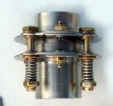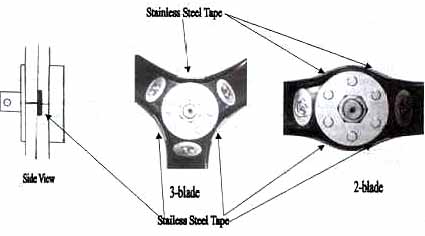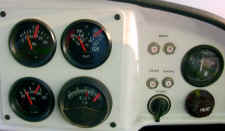| Preflight Engine To preflight the engine on the Aventura II, check to make sure the ignition switch is in the OFF position. Lower the flaps, place a short step ladder below the engine on pilots side of the hull. Reach forward and remove the oil tank cap and oil dipstick. Now turn the engine over by hand, turning in the direction of engine rotation until a "gurgling sound" is heard coming from the oil tank. Replace the oil stick into the oil can and then remove it and check the oil, Remember to replace the dipstick and oil cap! Remove the radiator reservoir cap and check the coolant. The level should be even with the center of the tank, more than that and fluid will vent out when it expands after the engine comes up to operating temperature. Editors Note: Rotax has RECENTLY updated the radiator cap from 14lbs to 18 lbs.
Editors Note: Rotax has updated the oil dipstick on the 912 series of engines, the top of the old dipstick was round the new dip sticks tops are rectangular. Look for any signs of leakage in the oil or radiator system. Check the spark plug caps. Check the ignition boxes and wiring. CAREFULLY check for signs of corrosion on ground cables, and wiring, especially if the craft is flown near salt water. Move the step ladder over to the other side of the engine and check the exhaust system, springs , optional alternator belts and brackets if installed. Remember you are flying a PUSHER anything that comes off the plane is going through the PROP! , optional alternator belts and brackets if installed. Remember you are flying a PUSHER anything that comes off the plane is going through the PROP! Editors Note: Exhaust springs should be safety wired and filled from tip to tip with silicone. This prevents any broken spring parts from flying into the prop. Another recommended update is changing out the springs to the new style of system shown here.  We are flying on a three blade medium IVOPROP. Check to make sure that the movement tape is in tact on all three blades. We are flying on a three blade medium IVOPROP. Check to make sure that the movement tape is in tact on all three blades. If the tape has broken DO NOT fly the plane until the prop has been checked and all of the bolts have been properly torqued. Broken tape means that the bolts are loose and the blades are moving in the hub. If you do not have a step ladder the Aventura has a step located on the middle of the main boom directly below the engine that can be used carry your weight for doing an engine preflight. It is a little awkward, and is not something I would recommend using if the engine is still hot! The rest of the plane is easy to preflight, as all of the control systems are out in the open and easy to get access to. Of course the hull should be checked from damage and water, this can be done by simply turning the bilge pump on. It is located in the center section of the lowest part of the hull, with an outlet about half way up the hull on the pilots side. The Aventura II also has two inspection and maintenance hatches, one on either side of the upper hull body enclosure just below the engine. Before taking off lets fuel the plane up using premium unleaded automotive gas. The filler cap for the optional 18 gallon tank, (12 gallon is standard) can be found just behind the pilot seating area on the outside of the plane. If you look between the seats you can see the fuel tank, on this unit the owner has marked lines on the tank for various levels of fuel, 2, 4, 6, 8, 10 and 12 gallons. You can also use fuel gauge located on the far right hand side of the dash. Now that we’ve done our preflight and fueled up lets board the plane. I will be flying from the right hand seat. Since I am short a 5' 6" I will have to put my right foot up on the tire, support myself with my left hand on the upper windshield, and step onto the seat with my left foot, bring my other foot in and then slide down into the seat. Once in I do up the aviation style seat belt with shoulder harness. (These are an improvement over the old Buc that just had a lap belt.) Slip on the headset and connect and turn on the intercom. Travis Jay has come down to the show to help the folks at Aero Adventure out and will be flying with me to make sure I bring this old girl back in one piece. Okay let's bring her to life! Check to make sure the throttle is at idle, apply the choke, turn the master, and two ignition switches on. Check the area for bystanders, if looks good YELL CLEAR PROP! Wait a second or two just incase we missed someone or something, then engage the starter. The Rotax 912 S turns over and then kicks back, but does not start. We try again same thing. Since this is a newer 912S, it is equipped with the slipper clutch, and heavier electric start motor, which should eliminate the hard starting. The problem may be that too small an amperage battery is being used, Rotax recommends a minimum 18 amp hour or more or because the battery is located in the nose we may be loosing some juice through the cables going back to the starter. The 912S comes to life on the third try, as it does I release the choke and the engine settles into a nice smooth idle. We've taxied out of the staging area, and into the departure area. Ground steering on the rudder pedals is very positive, visibility over the nose even for me is good. I use to have to lean a little forward to see over the Buc II nose while taxiing. Because of the slight cross and tail wind I am going to follow Travis along as he takes off. He deploys 20 degrees of flaps and waits for the signal from the flagman. We are given the green light to go. Travis has brought the stick back to neutral, as he gently but authoritatively applies power in one steady motion. The plane's tail begins to lift, he applies a little more back pressure to help keep it down, and a little right rudder and left stick to compensate for the torque and cross wind. With over half a tank of fuel, two pilots and gear the Aventura II is airborne in about 250 feet. Setting into a nice gentle climb at around 65 the VSI reads just over 600 feet per minute. At around 400 feet we level off, retract the flaps and set out for Lake Parker where we will be doing some work on the water. The plane settles in at 75 mph at 5200 rpm. (5 to 10 mph faster the a Buc II similarly equipped.)  But Houston we have a problem! Glancing at the instruments our oil pressure is just above 20 lbs. It would normally start out around 80 lbs. and drop down to 55 after the engine warms up! But Houston we have a problem! Glancing at the instruments our oil pressure is just above 20 lbs. It would normally start out around 80 lbs. and drop down to 55 after the engine warms up! I bring this to Travis's attention and he indicates that the gauge has been reading like that since he started flying the plane. Since the oil temperature and water temp are showing in the area 180 degrees F, and the EGT's around 1200 it appears the engine is running cold. If it was being starved for oil it should be running hot or NOT running at all. Rotax 912 engines are not known for running very long when short on oil! Editors Note: The oil temperature on a 912 should run around 230 degree F, the water temp 200 to 215. The 912 series of engines need to run these temperatures to "clean themselves out." EGT’s will generally sit around 1450 F. We continue on the Lake Parker, staying below 500 feet until we get out of the restricted area around Sun N Fun and then climb up to 1,000 feet. At Lake Parker we do a circuit of the lake checking for traffic and wind direction. Then set up for an approach, loosing altitude in the circuit until we turn final at around 250 feet. We reduce power to 3,000 rpm, deploy flap, retract the electric gear by simply moving the handle up and then back. The green light on the dash changes to blue to indicate gear is up and locked. Set up an approach speed of 65 and come it at what I consider to be a fairly flat angle. With this power setting we basically come in and land the plane on the water, once the plane touches, power is reduced and the plane settles into the water! Can't get much easier than that! But I am not use to coming in with power, I prefer to back power down to idle and make my approach so that I am turning final at around 700 feet. That way if the engine quits I can still make a safe landing. Also I find if you continually use power to land, the one time power isn't available for whatever reason, you have a problem. So let's try another one without power. As we turn back to set up for take off the one sponsor is dragging in the water because of the cross wind, making it difficult to turn. We back power down and then try it again. This time applying opposite aileron and a blast of power, she comes around without any problem. Just like the old Buc II be prepared to get at least you hand and arm wet as you come around. It's nice to know something's haven't changed. Another improvement over the Buc II is that the Aventura has a solid fiberglass top rear deck. On the Buc II this area was dacron sail cloth, which was attached to the hull using velcro. Water would enter the hull in this area. Also the velcro and or the glue holding the velcro to the hull would separate which resulting in water entering the hull, or worse the fabric being sucked into the prop. Now taking off from water was one problem that pilots, new pilots particularly could have with the old Buc II's. The procedure was, stick just forward of neutral, full power, compensate for the overhead thrust with back pressure on the stick as needed. Get her up on the step and then apply just the right amount of pressure on the stick to keep it from porpoising! If your timing was off, especially in glassy calm conditions you found yourself riding a bucking bronco! This same scenario happens on landing. The Aventura II showed no signs of that during landing. Nor during take off. We basically did the same procedure. 20 degrees of flap, stick to neutral, full power, plane comes up on the step, gains speed with no indication of any trend to porpoise, at around 45 mph lifts off and sets up in a nice climb out at 65 mph. We climb to altitude and set up in the circuit, on base I bring the power back to idle, flaps are still extended. The plane sets up in a gentle nose down glide, at 20 feet I start to level, 10 feet level, she floats in ground effect for about another 75 feet and then touches down, and settles into the water. We play around doing some fast step taxiing, take-offs and landings for another 30 minutes. The Aventura II gives you excellent feel and feed back in all aspects of it's operations. Taking off and climbing out to altitude we steer clear of Sun N Fun and level off at 1800 feet and set up as if we are going on a nice cross country. 5200 rpm, produces 75 mph, we adjust the trim, located between the seats. A pilot could easily and comfortably fly this plane hands off for hours once it is trimmed. We are using noise cancelling head sets, that are voice activated. Conversations between the two of us is relatively noise free, and I was quite surprised that the cabin noise was low enough that headsets were not continually clicking on and off. Turns on the Aventura II are effortless. You check the area out that you want to turn into. Apply light rudder pressure in the direction you want to turn, and the plane comes around. To come out of the turn just release the pressure and apply a little opposite aileron and you back straight and level. One thing you will notice, just like on the Buc II, is that there is a pile of pressure on the stick when you use the ailerons. The saving grace is that you only have to move them a little, and that the plane is extremely rudder dominated. For those wanting a little more excitement, application of a lot of rudder and aileron will really make this angel do a dance in the sky! But for the old guys like me that want, comfort and relaxation, with no headaches or surprises, the Aventura II fits the bill. Especially in a stall. Applying full power and climbing out with stick all the way back will only caused the plane to shudder she refused to drop her nose. With power back to an idle and full rear stick she started a little shutter at around 55 and then dropped her nose gently, automatically starting to fly 25 feet later. With 20 degrees of flap, and stick all the way back she simply shuddered, the nose would drop 5 or 10 feet and then start to fly. For a plane of this size, drag, and with a gross weight of nearly 1450 lbs. that is testament to how well it was designed. But all things must come to an end. It is time to get back to the airfield. We head back loosing altitude on route and enter the circuit. At about 300 feet on final we drop the gear, the blue light changes to green. Deploy flaps, the plane slows to 65 mph, sets up and nice gentle glide. With the engine at 3,000 rpm we touch down in a three point stance, bring the throttle back, apply the brakes and taxi back into the staging area. Where half a dozen prospective customers are anxiously waiting to take my place in the plane. |